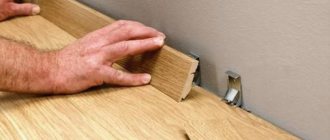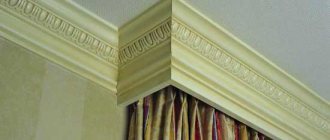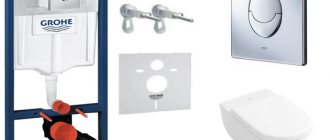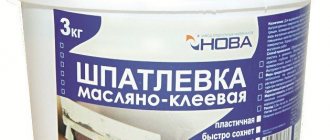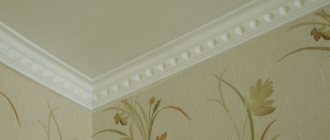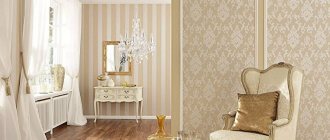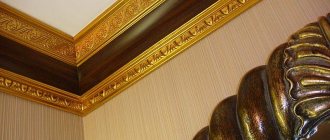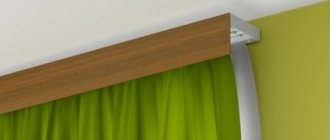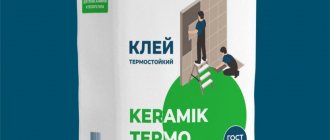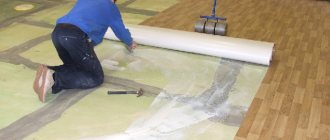Skirting boards delimit walls, floors and ceilings and add originality to the interior. They are made from a variety of materials. Installing them is not difficult if you choose the right adhesive, but how do you navigate among the hundreds of offers? Which company is better? All adhesives look the same at first glance, but each has its own characteristics and is intended for a specific use, depending on the type of work performed and the surfaces being glued. The editors of the YaNashla website have identified the best adhesives for ceiling and floor skirting boards for 2022.
Installation of floor skirting boards
Depending on the material of the plinth, there are several ways to install it. In particular, it is installed on staples, glue and screws. Let's look at these methods in more detail.
On staples
The advantage of this installation method is the absence of traces of fasteners on the outer surface of the plinth. The profile itself is easily installed on the brackets and can be easily dismantled.
Installation is performed according to the following algorithm:
- Make markings for installing fasteners. The first mark is usually placed 5 cm from the corner, the frequency of subsequent marks depends on how smooth the wall is. If the walls are smooth, the marks are placed less frequently, 50 cm apart, otherwise the step can be reduced to 20-30 cm.
- Holes are drilled in marked areas of the wall and plastic dowels are installed.
- Install the fasteners and secure them with screws in the dowels.
- Install the plinth onto the fasteners, having previously adjusted the elements to length.
- Special corner elements are installed at the corners, and plugs are installed in the door area.
Important! The distance from the corner to the first fastening element should not exceed 10 cm, otherwise the fastening will not be very reliable.
Video: installing floor plinths on brackets
On glue
Glue installation is the fastest way. This method is suitable if the walls, floor or ceiling are well leveled, otherwise the profile may sag over time.
Liquid nails (acrylic or neoprene), acrylic putty (it helps smooth out unevenness), special adhesives for polyurethane, and universal polymer glue are used as glue. Such brands of glue as “Titan”, “Dragon”, “88”, “Moment Montazh” are widely used.
Installation using adhesives proceeds according to the following algorithm:
- The plinth is fitted to the installation site using markings and a hacksaw, trimmed to length and joints are formed.
- If necessary, glue is prepared (some types need to be diluted with water).
- You can glue the profiles directly onto the wallpaper, but for reliability it is preferable to glue them on a prepared wall. To do this, the wall is cleaned of dirt and can be degreased.
- The glue is applied to the surface according to the instructions for use. For example, liquid nails are applied pointwise, and putty can be used to smooth out uneven areas and cover up cracks.
- The plinth is applied to the wall and held in this position until the glue sets.
- If any glue drips appear, they must be removed immediately with a spatula.
Important! Working with neoprene liquid nails requires good ventilation of the room. The pungent odor remaining after installation disappears after a few days.
For self-tapping screws
Typically, wooden or plastic baseboards are installed on self-tapping screws. This method is labor-intensive and requires certain skills and careful execution. But using this method you can mount profiles even on relatively uneven walls.
This type of installation is performed as follows:
- Profiles can be adjusted in length and for joints in advance; this can be done during installation.
- Through holes are drilled in the profiles for self-tapping screws, in increments of 40-50 cm.
- The holes are machined with a larger diameter drill to form conical recesses that allow the heads of the screws to be hidden.
- The plinth is applied to the installation site. Through the drilled holes, mark with a pencil the places for the dowels.
- Drill holes in the marked places and insert dowels.
- Reattach the profile and secure it with self-tapping screws.
- The screw caps are covered with plugs.
Video: installing skirting boards with self-tapping screws
How to install it yourself
Installing an MDF plinth yourself is not difficult. It is important to prepare the base, make even markings, and take your time while working.
The tools you will need are fasteners/glue, a tape measure, a building level, a pencil, an electric drill, and a spatula. Additionally, you need to prepare abrasive paper, primer, drills, hammer, varnish, masking tape, sealant, putty for working with wood.
Manual labor involves the use of a screwdriver, dowels, a miter box, a carpenter's square, and a hacksaw.
Calculate the quantity
Preliminary calculations help to make the cladding beautifully and save on building materials.
First you need to measure the perimeter of the room. A floor plan where all the data is plotted will simplify and speed up the work.
The doorway is subtracted from the total perimeter.
The next step is to calculate the number of strips by dividing the resulting number by the length of one product.
Next, they calculate how many planks will go on each wall, measure the required length, and perform trimming.
Carrying out pre-assembly cutting
This is called cutting blanks. To work, you will need a miter box, which will help form an angular cut. This is important for a tight fit in corners. The device is tightly fixed to a table or chair through the provided mounting holes.
The solid plinth is secured to the machine body with clamps so that there is no movement of even a millimeter during cutting. Even the smallest mistake will lead to the formation of gaps at the joints.
It is recommended to first cut the workpiece with a small margin, since it is rare to find even corners. Then it is better to finish the baseboard on site manually.
Make sure that the back side is pressed tightly against the frame and that there are no corners between the surfaces of the device and the workpiece.
Now cut the joint and apply the cut part to the corner to check the accuracy. The remaining parts are cut using the same method.
Installation
Installation of skirting boards made of any material is carried out in several stages with the preparation of walls or ceilings for fastening. It is necessary to think over the layout of the planks, the method of fixation, and prepare the necessary tools. It is better to take consumables with a small reserve just in case.
Preparatory work
When purchasing MDF skirting boards, take into account that the length of one strip is from 240 to 250 cm. This information is for correct calculations.
Reused panels must be carefully inspected for bending or noticeable defects. If there is no painting, but there are stains that cannot be removed, or it is impossible to remove dirt, such a skirting board will have to be thrown away.
New planks are inspected in direct sunlight, which helps to exclude coatings with a different shade. Darker elements should be placed in dark areas.
Lay out solid pieces along the walls, calculate the material so that the joints are created in the most inconspicuous parts of the room and are not noticeable.
On those panels that are planned to be adjusted to size, markings are applied. It is recommended to cut on the side that will be adjacent to the corner, since this is where the cuts will be compressed, where light defects can be visually hidden with putty.
Cut the workpieces with a hacksaw, firmly fixing the position in the miter box.
To make the joining neat, you need to start moving the tool from the front to the back. When connecting two straight lines on the wall, maintain a cut angle of 90 degrees, for attachment in a corner - 45 degrees.
Immediately after trimming, the processed edges are sanded with sandpaper or a file.
Attaching with glue
The quality of gluing depends on the preparation of the working surface.
It must be completely cleaned, degreased, and the substance must be applied to the back side of the baseboard in small dots with fine increments.
Applying glue to the baseboard pointwise
Next, you need to press the panel tightly against the wall or ceiling and hold it without moving for the amount of time specified by the manufacturer.
We put it on self-tapping screws
When fastening with self-tapping screws, you will first need an external plank, attach a plinth, drill holes in increments of 25-30 cm, and insert dowels inside the wall. All that remains is to install and secure the panel, and install the bar back.
Fastening with self-tapping screws must be accompanied by high-quality camouflage
The use of liquid nails requires leveling the main surface: a small protrusion or depression will prevent the two parts from bonding to each other.
Clip mounting
If staples are used, the work is not dusty. A panel is put on them and removed if new repairs are carried out. It becomes possible to remove the plinth without defects and reuse it.
Installation of skirting boards with special clips
Products made from MDF create a neat, noble look. When used indoors without sudden changes in temperature or air humidity, there are no difficulties in maintaining shape.
You can clearly see the process of gluing MDF skirting boards in the following video:
Source
Why do you need a flexible floor plinth?
The design of curved walls, round columns and half-columns often becomes a problem. The walls in the bay window are also usually round. Some people make rounded corners. All this looks beautiful and adds uniqueness to the house, but problems arise in the finishing. One of them is in the selection of skirting boards. They are usually in the form of slats, and quite rigid ones. The question arises - how to design curved surfaces?
To decorate curved walls and columns there is a special plinth - soft, flexible, elastic
In general, there are flexible skirting boards. They are also called bendable, radius, soft, radial, or they are written as such - “for columns”. There is also plinth tape. This is a strip of vinyl divided along a fold line (pictured below). There are products that are more similar to traditional skirting boards. For example, FLEX LINE CEZAR, SALAG, FN Neuhofer Holz, Korner IDEA 80 (for painting) and Ultima 80, Nova 70 with cable duct, Arbiton made of thin metal. Some materials can be made to bend when exposed to temperature or special treatment. In general, there are opportunities.
Why do you need a ceiling border?
There are no categorical prerequisites for installing ceiling cornices, except for situations when you need to hide wall imperfections. Usually this design fragment is used as desired. But it still has undeniable advantages.
Ceiling plinth solves the following problems׃
- masks not very smooth seams at the corners;
- helps to make the angle between the walls and ceiling ideal;
- you can hide the cable;
- with a successful element shape, the height of the room visually increases;
- hides gaps between suspended ceilings and walls well;
- You can install hidden lighting on one of the walls or along the perimeter of the room.
To make a room look good without borders, you need to achieve a perfectly flat surface of each wall and ceiling. This is especially important when the design involves different colors and shades.
Ceiling cornices are distinguished
Narrow baguettes will look good with low ceilings. For a room where the ceiling height is 2.5 or 3 m, medium-sized elements will be more concise. For huge rooms with very high ceilings (about 3-4 m), fillets with a width of 160 mm or more are used.
Patterned borders focus attention on the ceiling line. The finishing materials market offers baguettes of various sizes and patterns. It’s easy to find the most suitable one to bring your ideas to life and create a unique interior. Cornices without a pattern look strict and noble. They unobtrusively emphasize the discreet classic design of the room.
How to treat the surface → Room decoration → How to choose the right paint → Surface treatment technologies → Leveling and finishing the walls → Selecting and applying a primer → Removal from the surface → Stretch ceilings and technologies → Reviews and testimonials
Expert opinion
Strebizh Viktor Fedorovich, leading construction foreman
If the question arises of how to glue moldings to a wall with wallpaper, then it is advisable to choose them from a material that is lighter, for example, polyurethane. If you want to clarify something, please contact me!
Installation of polyurethane ceiling plinth
Now let's see what technology is used to install polyurethane skirting boards on the ceiling. Their installation is carried out in several stages.
Choosing adhesive for planks
To install polyurethane elements, you can use super-strong Moment Montazh glue or any other similar liquid nails. Also, sometimes the planks are secured with adhesive intended for tiles. However, the best solution would be a special adhesive for polyurethane skirting boards. In this case, for a city apartment you need to choose an option designed for gluing planks of this material to concrete.
Polyurethane elements are glued with special glue
To glue the ends between the planks, use a special glue for joints. After its application, a melting effect occurs. As a result, when the elements shrink, the joints do not subsequently diverge.
Surface preparation
The surface of the ceiling and walls must first of all be thoroughly cleaned of dirt and dust.
It is very important to remove all grease stains
The walls and ceiling must be degreased before gluing the polyurethane ceiling plinth. Photo of surface cleaning
Tip: Degreasing can be done with a solution of some alkaline household detergent. Of course, you should wait until the surface is completely dry before installation.
Next, the surface of the walls and ceiling is primed. This step is optional and can be skipped if desired.
How to glue polyurethane strips
Mount the polyurethane ceiling plinth as follows:
- The plank is coated with glue on the side on which it will adhere to the surface of the walls and ceiling;
- Next, you should press it tightly to the surface and hold it there for a while;
- After this, it is torn off and waited for about one minute;
- Next, it is again pressed against the ceiling and wall and held in the desired position for another minute.
Ceiling plinth made of polyurethane. Photo of a tightly pressed bar
- The joints and cracks between the ceiling and the slats are puttied. You can use acrylic sealant for this purpose.
The gaps between can be sealed with putty or acrylic sealant
Tip: On a curved surface, the planks can be temporarily secured with small nails to prevent them from coming off. After the glue sets, they are pulled out with pliers.
This way you can securely attach the polyurethane ceiling plinth. Installing it (the video demonstrates the step-by-step process) with glue is a matter that requires a certain amount of accuracy.
Mechanical installation
Sometimes polyurethane skirting boards are attached to the ceiling and walls mechanically. In this case, the corner elements are mounted first. Next, a mounting plate, which is included in the kit, is installed on the wall using self-tapping screws in increments of 30-50cm. At the final stage, the plinth is simply snapped onto the plank elements.
Polyurethane plinth can be installed on special strips
It is best to attach polyurethane elements to suspended ceilings mechanically. Firstly, due to vibrations of the canvas during drafts, the strips attached to the glue can become loose and move away. Secondly, due to the effect of the adhesive composition, wrinkles often form on the canvas.
Decoration of corners
Without using special elements in the corners, the polyurethane ceiling plinth is fixed by first cutting off the ends of the planks at an angle of 45 degrees. A miter box is used for this. In both cases (when installing with glue and with self-tapping screws), the ends of the two corner strips must be glued. It is best to do this before installing the baseboard in place. In this case, it is worth using glue intended for joints of polyurethane planks. It holds very well, and therefore the corner of two planks will not fall apart. How to cut planks? Most often, a regular stationery knife is used for this.
Cutting polyurethane plinth using a miter box
Installation methods
There are three methods for installing products. When resorting to one of them, it is worth considering the possibility of dismantling . In the event of an emergency (for example, a pipe leak), the covering will have to be removed, and the faster and more successfully this happens, the greater the chance of keeping the floor safe and sound.
On glue
If the back surface is fairly flat, you can mount the structure using liquid nails or polymer glue. However, in this case, dismantling will be extremely difficult, which may damage the planks.
Next, take the second plank, previously adjusted to the first, and join it in any chosen way. If the use of joining parts is not provided, after treating with glue, the plinth is placed tightly against the first plank so that there are no gaps left.
If you plan to use connecting posts , the first post is placed in the corner of the room, and a strip is glued to it on both sides. If corner elements are used, installation is carried out in the same way, but the strips are not pressed, but inserted into the grooves.
For clips
The simplest and most convenient installation of floor plinths. Metal or plastic clips are pre-fixed, corresponding to the fastening channel on the back side of the element. As a rule, they already come complete with the baseboard. By attaching it in this way, you can remove the structure at any time and then reinstall it.
For self-tapping screws
The structure is screwed to the wall surface. The dismantling process will take more time, but such fixation of the planks is durable and reliable. In some cases, self-tapping screws are combined with liquid nails.
Next, the strips are attached and secured with screws. Cables are being pulled. Joints can also be installed in several ways, as with liquid nails. Skirting boards are put on. The fastening system may vary, but if necessary, even an untrained person can handle it.
Advantages of plastic skirting boards
Among the types of skirting boards, plastic is the most popular for many reasons. Polyvinyl chloride is famous for its durability and strength.
The service life of plastic floor planks reaches 100 years. They are resistant to fire and moisture, safe, so they can be installed in any room.
Dimensions and design of plastic skirting boards
Skirting boards are easy to install, cut with a sharp knife, and their cost is not high.
Compared to wood and plaster planks, plastic planks are flexible. They have a huge color palette, which does not limit the choice of color for the interior of the room and allows you to fit into the overall background as much as possible.
An additional advantage is that some models are equipped with a special trench into which the wires are laid.
How to choose glue for gluing foam baseboards and gluing plastic frames
There is an adhesive for each type of material. Therefore, it is important to choose the right product:
- Acrylic putty is suitable for foam and polystyrene.
- Plastic products are fixed using sealant and acrylic putty.
- Polyurethane skirting requires a special adhesive for this material.
- Gypsum elements are attached to a mixture of alabaster and PVA.
- Wooden skirting boards are fixed with liquid nails if the product is not heavy, otherwise self-tapping screws are used.
The above-described fastening methods and types of material will allow you to complete the finishing touch. Compliance with the type of plinth and compliance with installation technology will be the key to reliability and a long service life.
Product trimming
Proper trimming of the material used affects the final result. Therefore, when the problem arises of how to attach a larger plinth, you need to use simple tips:
What to cut with? For this process, a metal saw with a blade having small teeth is used. As an alternative, you can use an electric jigsaw, to which special files are selected. When the parts have already been fastened, but there is a need for minor adjustments, use a sharp construction knife
This device must be used very carefully so as not to damage the front side. It is advisable to cut the plinth only after careful measurements. To trim at the desired angle, use a miter box.
Trimming the plinth: outer and inner corners, arrangement of parts in the miter box
Such simple tips greatly facilitate the process and allow you to install the elements with the highest quality.
Application of high-quality Moment glue
Perhaps the best glue, which has an advantage over the two above-mentioned samples, is instant ceiling plinth glue. Its setting time is faster and the baseboard holds tighter. However, Moment glue also has a negative feature: its cost is higher, and it also consumes more than other products. Moreover, to use Moment glue, you cannot do without a sealant gun.
Detailed videos of the process of gluing skirting boards to the ceiling, as well as photos of finished ceiling options, can always be found from specialists involved in interior decoration.
Advantages and disadvantages of polyurethane skirting boards
The main advantage of this decor is its flexibility. It can be simply an ideal option for decorating apartments whose walls have a complex configuration - they have rounded corners, niches and arches. Of course, it will look good on flat surfaces as well. How apartments decorated using such planks might look like, look at the photo:
Pros and cons of polyurethane ceiling skirting boards
Polyurethane ceiling plinth has a number of undeniable advantages:
- A wealth of colors and textures. In addition, you can use both wide and narrow decor options to decorate the room;
- Easy to care for. In case of contamination, such strips, unlike foam ones, can simply be washed with a solution of any household detergent;
- Ecological cleanliness. If desired, such a ceiling plinth can be glued even in children's rooms. Polyurethane foam is a foamed plastic material. Essentially, this is the same foam rubber, only hard and flexible;
- Resistant to deformation. You can use this decor, unlike the same wood, even in bathrooms.
Polyurethane strips can imitate stucco
Ceiling plinth made of polyurethane has only one, but quite significant drawback - heavy weight. Foam planks, for example, are much easier to install.
Important: Polyurethane foam skirting boards should only be fixed with special glue. Otherwise, they will soon simply move away from the walls and sag.
Floor plinth
Floor plinth made of polyurethane has all the advantages of a ceiling plinth. In addition, one can also note its advantage such as mechanical strength. In case of an accidental impact, it does not form scratches, like a wooden one, or holes, like a plastic one.
Polyurethane floor plinth looks very neat and at the same time is characterized by mechanical strength
Being used for both floors and ceilings, due to their elasticity and flexibility, polyurethane strips perfectly hide all the imperfections of the wall surface.
In addition to the heavy weight, the disadvantage of this type of decor, both floor and ceiling, is also considered to be quite high cost. Its price is comparable to the price of wood. However, this floor framing looks no worse:
Product design and its advantages
So, MDF skirting boards are made from fine wood fraction. Naturally, the main raw materials for production are natural and environmentally friendly. The baseboard also contains not entirely safe components: epoxy resin, phenol. During operation they do not pose a health hazard.
To manufacture the product, the vacuum pressing method is used. Next, special textured paper with a pattern is glued onto the workpiece. It provides a decorative finish. This paper is saturated with dye. While using the product, you do not have to worry about the top layer peeling off.
A protective melamine coating is applied over the paper. Laminated plinth has a beautiful appearance, is not susceptible to the negative effects of external factors, and does not fade. You can also purchase a plinth and then paint it yourself.
Laminated floor plinths have the following advantages:
- Affordable price.
- Excellent decorative qualities.
- Resistance to the negative effects of sunlight.
- Possibility of laying wires and cables inside the baseboard.
- Resistant to dirt and easy to maintain.
However, there are disadvantages: relative fragility, insufficient resistance to scratches and mechanical damage.
Pros and cons of fixing floor plinths with glue
When attaching plastic skirting boards to the floor, it is preferable to use adhesives. This choice is due to the fact that liquid nails:
- do not cause mechanical damage to the baseboard, walls and floor;
- provide quick and reliable fixation;
- are distinguished by universal properties (able to stick to almost any surface);
- create an elastic and elastic connection that does not allow moisture to pass through.
The main disadvantage of liquid nails is that the surfaces must be leveled before gluing the baseboards. Without this, the structure will not be fixed to the wall or floor.
Criteria for choosing adhesive for baseboards
The industry does not produce highly specialized types of glue for attaching skirting boards. The consumer has to choose from a commercially available assortment list. And he is impressive.
However, not all adhesives guarantee long-lasting results. Therefore, when making a choice, it is necessary to take into account some characteristics of the adhesive. Glue for floor plinths and baguettes should:
In addition, it is necessary to take into account the price factor and the environmental friendliness of the components of the composition.
Types of compositions used
In construction, during the renovation of residential premises and their final finishing, the following adhesives are used:
- liquid Nails;
- silicone sealants;
- docking;
- putty;
- polymer compositions;
- hot melt adhesive.
Liquid Nails
It is considered a universal glue used to work with:
- tree;
- metal;
- drywall;
- glass;
- Chipboard.
The substance reliably fixes the glued elements to each other, allowing you not to worry about the safety of the repair. The only drawback is considered to be poor compatibility with wet surfaces, which do not allow the composition to adhere securely.
Silicone sealants
Viscous adhesive compositions, among the main advantages of which are:
- fast hardening;
- seam elasticity;
- waterproof;
- long service life.
Does not perform very well when working with wet surfaces or materials containing plastic.
Docking
Special adhesive for working with skirting boards, which often contain polyurethane. It is much more effective than liquid nails. Used to fix ceiling plinths at joints and transitions. Pros of glue:
- quickly sets to the work surface;
- paint adheres well to it;
- has great adhesive ability.
Polymeric
A universal product with a large number of positive reviews from customers. Pros:
- strong adhesion to the surface being treated;
- dries quickly;
- economically used;
- easy to apply even to hard-to-reach areas.
putty
Putty is considered a worthy alternative to glue. Its use allows you to achieve:
- reliable, durable fixation of the baseboard;
- quick drying of the seam.
Flaws:
Working with putty is more difficult than working with glue and, in most cases, only experienced finishing workers work with it.
Hot melt adhesive
It is used in cases where large temperature changes are recorded in the room where the skirting boards are installed. Hot-melt adhesive is easy to apply, does not have an unpleasant, specific odor and hardens quickly.
Liquid Nails
Suitable for almost any material, liquid nails are popular in finishing work. The product is acrylic or neopropylene. If the "Titan" and "Eco-naset" glues have disadvantages mainly in the installation process itself, then liquid nails pose a danger to humans due to their composition. This applies to neopropylene samples: they have a very pungent odor. However, the harmful effects only apply during installation; after complete drying, the smell disappears.
The advantage of neopropylene liquid nails over acrylic nails:
- have greater strength;
- resistant to low temperatures;
- moisture-resistant, can be used for installing tiles in the bathroom;
- set faster.
Pros of acrylic glue:
- faint odor
- harmless to human health.
Skirting installation options
The plinth can be attached to the floor in various ways. These include:
- attaching with screws and nails;
- anchor or clip fastening;
- gluing to the back;
- Using self-adhesive baseboard on the floor.
This way you can securely fasten the planks to the designated location without damaging the structure. Most often, this method is used when working with wood products that can crack under the influence of a hammer or screw.
Elements for fastening plastic skirting boards.
The objective advantages of liquid nails include, first of all, the fact that their use in no way spoils the surface of the finishing material. After fastening, no dents or abrasions from the hammer can be noticed. At the same time, you will not have to worry about decorating nail heads or screws, which will remain noticeable in any case. The advantages of attaching skirting boards with liquid nails are:
- high quality adhesive fastening base;
- quick fixation of connected parts;
- Possibility of use with any building materials: from natural wood and stone to synthetic materials such as ceramics, plastic and MDF.
- Among the advantages is the possibility of using these fasteners in conditions of high humidity levels, due to which it will be possible to glue skirting boards to the floor in any room of the house: living room, kitchen, bathroom or toilet.
Tools
The surfaces to be joined must be cleaned and dry (especially important for plastic). The surface of the walls at the joints is treated with a primer
The master will need sandpaper and a primer with a roller.
Necessary tools also include:
- a hacksaw (for cutting the required length of plastic sheets) or a grinder;
- tape measure (at least 3 m);
- miter box (carpentry device for cutting and sawing planks at an angle);
- rubber hammer;
- silicone spatula with blade (4 cm wide);
- joining angles for internal and external connections;
- construction gun for cylinders for squeezing out the adhesive base on the surface;
- a clean old rag that can be used to quickly wipe the stain before it dries.
The baseboard itself must be painted or varnished in advance and then allowed to dry. This will prevent the walls and floor from getting dirty. Self-adhesive skirting boards require no tools. Using a hacksaw for metal will prevent ragged edges.
Trimming skirting board corners with a miter box
Trimming without miter box
If you don’t have a miter box, you can make the corner joints of wooden baseboards yourself. All segments must be laid out around the perimeter of the room. At corner joints you need to mark the surface of the walls with a marker. The result will be four points in each of the corners.
- Alternately, the left and right parts must be attached to the wall, marking their joints on the wall with points 1 and 2. Then, alternately, draw a line perpendicular to the wall from the points. As a result, point 3 appears on the fillet.
- Lines are marked on the floor along the bottom edges. Point 4 is the intersection of these lines.
- It remains to connect point 3 to point 4 diagonally.
- The corner is cut with a hacksaw. In this case, the other side of the cut (which will be glued to the wall) should go along the edge. As a rule, the angular cut is 45 degrees.
What types of glue are there?
The choice of mounting adhesive for attaching the ceiling plinth is determined based on the weight of the part and the material from which it is made. To firmly glue molding to a ceiling or wall, you need a quick-setting adhesive that will not lose its properties over time under the influence of ultraviolet rays, moisture or temperature changes. You can attach the plinth to the surface to be decorated using various quick-drying compounds, but you should know that so-called liquid nails are suitable for smooth surfaces of the molding, and styrofoam adhesive-mastic is used for working with porous surfaces.
The most commonly used adhesive compositions for installing ceiling plinths are divided into groups.
Polymer mixtures
This is the most common type of adhesive composition, which has good viscosity, as well as the property of rapid hardening. Polymer adhesives are quite resistant to temperature changes, ranging from positive to negative values; such compositions can work in the range from -60°C to +80°C. Installation work can be carried out with polymer glue both in a warm room and in unheated areas.
Glue made from polymers is resistant even to very high humidity, so it is used for attaching ceiling plinths in the bathroom or kitchen.
As for the cost of such glue, it belongs to the budget and mid-price options
Although it is necessary to take into account that such a product has a certain shelf life, and when it comes to an end, trading companies reduce its price in order to quickly sell the goods left on the shelves. It is not recommended to use adhesives that have expired
In terms of versatility, the polymer product is very convenient. It can be used to glue moldings made of polyvinyl chloride, polyurethane, and foam. This composition does not corrode the surface of the decor and provides it with good adhesion.
Liquid Nails
This type of adhesive composition is universal; it is suitable for fillets of any type, made of any type of material. Liquid nails set quickly and securely hold even heavy polyurethane skirting boards. The composition of liquid nails is designed in such a way that it does not destroy the surface being decorated and the molding mounted to it.
There are two types of liquid nails.
Acrylic composition is a modern universal adhesive that is not toxic to humans during installation work, since it contains acrylic and water, but at the same time the adhesive is not able to withstand the effects of high humidity. For this reason, acrylic liquid nails are not used for installing ceiling decor in the bathroom or kitchen.
The use of liquid nails is advisable where the surface to be decorated is flat and smooth, since these adhesive mixtures do not provide the opportunity to correct small imperfections in the wall or ceiling. Liquid nails can be used on baseboards made of wood, polyurethane, plaster or polyvinyl chloride.
Tips for the best use of any glue
Each glue is different from the other. It is necessary to study the instructions on the package to make the best use of the product. Some of the rules are relevant for all cases:
- The surfaces of the objects to be glued are pre-cleaned and degreased, because even skin oil and sweat can reduce the effectiveness of the glue.
- If possible, glue is applied at a temperature of +10 to +15°C; these are ideal conditions.
- Gloves are always used, inhalation of glue vapors is avoided, and the room is ventilated.
- Contact of the substance with skin and eyes is not advisable.
- If your fingers stick together, as this inevitably happens with some types of glue, you should wash your hands with hot water and soap, trying to gently separate your fingers with a metal spoon, but not with sharp objects.
- Before closing the tube, the nozzle is cleaned and any streaks of glue are removed to avoid hardening so that the product can be used without obstruction next time.
- The glue should not be left in places accessible to children and pets.
- Store glue in a cool, dry place, away from food and drink areas.
Types of plastic floor skirting boards
The range of products is presented:
- Skirting boards with different methods of making the base. From this parameter, all plastic skirting boards: semi-rigid, characterized by increased flexibility, can be installed on curved areas without problems, can be painted to match the color of the walls; hard - the most accessible and common; soft - foamed. The latter have good thermal insulation and are often needed to reduce heat loss through the floor.
- Products with different functionality. Depending on the intended purpose, there are ordinary decorative plastic strips with a solid cross-section, hollow plinths with a cable channel to hide electrical communications.
- Materials compatible with different types of floor coverings: universal profile with rubberized inserts along the edges; ordinary plinth for linoleum, simply screwed to the walls or floor; L-shaped for carpet, with the function of pressing the covering (fixing a strip of carpet on the outside of the profile).
The outer covering can be matte or glossy; it is possible to combine colors and textures with the floor covering. Individual standards are put forward for quality, according to GOST, they have the same cross-section along the entire length, clear dimensions, smooth outer coating and neat edges. With a standard length of 2.5 m, the width of plastic skirting boards is in the range of 14-24 mm, height – 40-150 mm.
Conclusion
Knowing how to fasten different skirting boards to a concrete wall in different ways - using self-tapping screws, glue and clips, you will be able to do this work yourself. The installation procedure of the panels is not difficult, but, as with any work, attention and skills are required.
Having different options for fastening panels, it will be easier to choose the most suitable option for the final stage of floor finishing. Only careful preparation and the correct method of fastening guarantee quick installation, and the purchase of additional material to redo the work is eliminated.
Types of fillets
Fillet is the second name for a plinth, received for the presence of a groove on the outside of the part. Among the most common materials used in the production of fillets are:
- foam products;
- polyurethane products;
- wooden baseboards;
- PVC profiles.
Polyurethane
Polyurethane skirting boards differ from others due to:
- The density of the material, thanks to which polyurethane products are strong and durable.
- Beauty. Decorative elements on polyurethane are more clearly visible than on other materials.
- A large selection of colors and styles, significantly expanding the model range.
- Possibility of installing hidden suspension.
Foam
A material that, despite its low cost, has a decent set of positive characteristics:
- low weight of products;
- ease of installation.
Flaws:
- fragile;
- afraid of high temperatures;
- does not interact well with some types of glue.
PVC profile
Affordable and high-quality material, noted by both professional finishers and ordinary people. Pros:
- heat resistance;
- does not collapse under the influence of ultraviolet radiation;
- easy to process and install;
- not afraid of exposure to water.
Minuses:
- not suitable for installation on curved walls;
- When exposed to high temperatures for a long time, it begins to deform.
Wooden
This material is gradually falling out of use, being replaced by cheaper and more practical counterparts. Despite this, wood skirting boards have many advantages:
- service life is not inferior to most alternative materials;
- wood products are the most environmentally friendly;
- beauty;
- can be painted.
Flaws:
- difficult to install;
- are expensive;
- Wooden skirting boards require special care.
General information about MDF skirting boards
MDF is a finely dispersed pressed fraction. The material is very similar to chipboard, but is considered environmentally friendly, safe for health, durable and strong. In the process of its production, epoxy resin and phenol are used.
A film impregnated with dyes is attached to the front side of the plinth under the influence of high temperatures. Thanks to this technology, the risk of peeling is minimized. A protective coating is applied over the film to prevent moisture penetration and contamination.
The plinth performs the following functions:
Modern skirting boards can be used as a decorative element, playing with colors, shapes, patterns, which allows you to complete your design idea and turn even an ordinary room into a cozy corner.
Features of the material
The main purpose of the plinth is to complete the overall appearance of the interior, as well as to hide all the shortcomings of the connection with the wall. You should also know that planks made of different materials have their own characteristics. Plastic panels are equipped with additional parts that simplify the fastening process - these are:
- end caps;
- linear connectors;
- corner details of internal and external location;
- brackets.
Additional details are designed to hide joints, including corner joints.
The planks have special recesses designed to hide utility lines (cables, electrical wires, wires). Given this feature, you should know how to attach a plinth to a concrete wall so that it fully fulfills its function and looks beautiful. This minor detail makes plastic products more practical compared to their wooden and MDF counterparts. Additional elements are sold separately, as each situation requires an individual quantity. Installation is carried out with special fasteners.
How to calculate the required amount of material for self-installation?
Before purchasing what you need for work, you need to calculate how many strips you will need
It is important to know what length of skirting board is required. It is worthwhile to immediately buy additional parts and connecting elements
If the room has a non-standard shape, then the number of elements will increase.
To understand how long the baseboard is needed, you need:
Measure the length of the walls in the room, taking into account the protrusions. You will need information about the thickness of the walls and doorway. If you have a plan of the room, this will simplify the task. If it is not there, then it is better to draw it. It is convenient to indicate the measurement results on the drawing. You need to calculate the total length of the walls and subtract the width of the doorway from the resulting value. The result will be the total length of the baseboard. It's better to take extra. Usually they add 10-15% of the total amount. When the length is known, it is divided by 2500 to obtain the quantity. It is believed that the value of 2500 millimeters is the standard length of the bar. Taking into account all the calculations, you can calculate the number of joints
It is important to calculate all internal and external angles from the drawing, as well as how many connecting elements will be needed
Installation of polyurethane floor plinths
Next, we’ll look at how to attach a polyurethane floor plinth. It is also usually mounted with special glue. Gluing decorative skirting boards should begin from the corner of the room. The work is carried out in several stages:
- The surface of the walls and floor is being prepared for the baseboard. They must be thoroughly cleaned and degreased;
- The plank is coated with glue on the reverse side. There are special grooves (shelves) here. The composition must be applied specifically to them, as well as to the ends;
Glue is applied from the back side
- The floor plinth is pressed tightly against the wall and held there for several minutes. You can press it against the wall with something heavy;
- The joints between the planks are treated with acrylic sealant.
Tip: In places where the walls are uneven, the polyurethane floor plinth may come off slightly. In order for it to stick evenly over the entire surface, you just need to nail it down not all the way. After the glue sets, they can be pulled out. It is worth nailing the strips at the corners as well.
The wide polyurethane floor plinth looks very impressive in the interior. They glue it using the same technology. However, since it can shrink quite significantly, the joints between such high planks sometimes diverge after some time. In this case, you should wait until the gap stops growing, that is, the baseboard shrinks completely. After this, the old glue will need to be removed. Next, the split seam is filled with joint glue using a syringe. Since it forms a foam, care should be taken that it does not reach the surface by approximately 2mm when applying.
Wide floor polyurethane plinth looks very impressive, but is somewhat difficult to install
Polyurethane plinth can also be mounted mechanically using self-tapping screws. The video below shows this process step by step:
Preparation for installation
Before installing the planks, it is necessary to carry out preparatory measures. The main task is to level the surface to ensure the most tight fixation of the plinth to the walls. If there are bulges and irregularities in the treated area, they are eliminated with putty. To prevent damage to the floor covering, it is covered with polyethylene.
calculation of a metal stove for a bath
Subsequently, the wall is coated with a primer . In this case, each layer must dry before applying a new coating. After priming, beat off the bottom line , which should be 15-20 mm below the height of the slats. This process is especially important when installing wide elements. Finally, finishing is carried out.
Tools for work
To install MDF skirting boards correctly and conveniently, you will need to prepare some tools:
In addition to the planks themselves, you need fittings : right and left end caps (they are not interchangeable), outer and inner corners, joining parts.
Calculation of material quantity
Before purchasing MDF plinth elements, you need to calculate how many strips you will need, as well as how long they should be. You also need to calculate the number of additional elements in advance, especially if the room has a non-standard shape and thick walls that are not perfectly smooth.
The following measurements are carried out:
Afterwards, the number of internal and external corners is determined, taking into account doorways. You also need to calculate how many left and right plugs you will need.
When performing the necessary calculations and measurements, take into account the following point, which is equally applicable to all installation methods: measurements are carried out separately for each wall, starting from the corner of the room.
Cutting the baseboard
To cut the planks, you need to use a miter box and a hacksaw . These tools make a neat cut at the desired angle. If you plan to connect planks without joining elements, cut them off at an acute angle of 45 degrees. Before cutting the plinth, all previously taken measurements are accurately applied to the material.
Selection and purchase of materials and accessories
There is a wide selection of different types of skirting boards
Sometimes when purchasing, it is important not only to decide on their appearance, but also to know the properties of a particular type of decorative element, to understand its advantages and disadvantages. Let's try to understand this issue
Wooden
This type of plinth is classic. Currently, wooden elements are often high-status and made from expensive wood. They can be both floor and ceiling.
There are two types:
- the base is made of inexpensive solid wood, which is covered with veneer made from valuable species;
- the entire element is an array made from one type of wood.
We recommend reading about how to install a socket and switch, how to remove paint from walls, whitewash from ceilings, how to hang wallpaper, how to make a plasterboard partition with a doorway, and also how to sheathe walls with plasterboard.
The advantages of such a plinth include its beautiful appearance and texture, as well as environmental friendliness. The disadvantages are high cost, tendency to deformation from moisture, and difficulty of installation.
Plastic and polymer
In this category, there are skirting boards made from several materials on the market. They all have their own characteristics, namely:
Skirting made of polyvinyl chloride (PVC) can be used for both floor and ceiling. Advantages include affordable price, ease of installation (special fasteners included in the kit are used), flexibility, durability, resistance to external conditions (moisture, fungus, etc.), ease of maintenance. Disadvantages include the lack of wide elements and exposure to heat, which leads to deformation and makes it undesirable to use a plinth made of this material above a kitchen stove or in the area of powerful light sources;
polyurethane plinth is used in both floor and ceiling versions. The high flexibility of the material allows it to be used for decorating rooms with complex configurations (niches, arches, curves). In addition, it is durable, strong, resistant to moisture and temperature changes, environmentally friendly, and easy to care for. The disadvantage is its relatively large weight, which makes installation of ceiling elements difficult;
elements made of polystyrene (polystyrene foam) are suitable only for making joints between the wall and the ceiling; they are too fragile for the floor. Products made from this material are inexpensive, lightweight, resistant to deformation and fungi, and can be painted. Disadvantages include fragility and the ability to crumble during processing. Extruded polystyrene has greater strength and crumbles less, but also costs a little more.
Ceramic
Ceramic plinth can only be used for flooring. It has a rather narrow range of application - it is perfect for rooms with floors covered with ceramic tiles. The advantages include durability, strength, ease of maintenance, and absolute resistance to moisture. The downside is the fragility and relative complexity of installation.
You will probably be interested in reading about how to install blinds on plastic windows, a water heater, a shower stall, an instantaneous water heater and an air conditioning system.
Fibreboard, MDF skirting boards
Made from MDF (also known as medium-density fiberboard), the plinth can be used for both ceiling and floor. Products made from this material are inexpensive, resistant to moisture, and do not fade in sunlight. But at the same time they are fragile, scratches and other mechanical damage quickly appear on them.
MDF products
The original version of MDF is created by pressing sawdust under high pressure and high temperature. The result is a dense, environmentally friendly material.
Additional adhesives are not needed, since a natural agent, lignin, is released under thermal influence. It tightly binds small particles into a single structure.
MDF blanks
MDF is a fine fraction, small wood residues are used.
There are unscrupulous manufacturers who use chemical compounds in production. In order not to buy a potentially dangerous material, you need to study the manufacturer's ratings in advance and read reviews from previous customers.
When creating the material, incompletely processed raw materials are used. The produced blanks are cut and processed on a milling machine for molding and applying a relief pattern. The front part is laminated with a polymer self-adhesive film.
There are models with an insert that helps hide fasteners after installation.
Sometimes the front surface is painted or covered with veneer made from expensive wood. The resulting products are indistinguishable from natural wood.
Painted products are treated with paint that protects against the negative effects of air humidity and detergents. When a specific shade is required, you can buy primed blanks in a light color. That’s what they’re called – for painting.
Choose skirting boards in accordance with the state of affairs. It is important to buy the best option in color, shape, size to fit into the design style.
Often the required models are offered when purchasing flooring. The hardware store will present a possible color palette that matches the selected flooring. All that remains is to find a shade that matches the color of the walls and furniture.
The combination of painting the MDF plinth with the frame of the doorway looks great. The difference from the floor covering is one tone. You can freely take the same color as the ceiling elements.
soup in an empty room video
